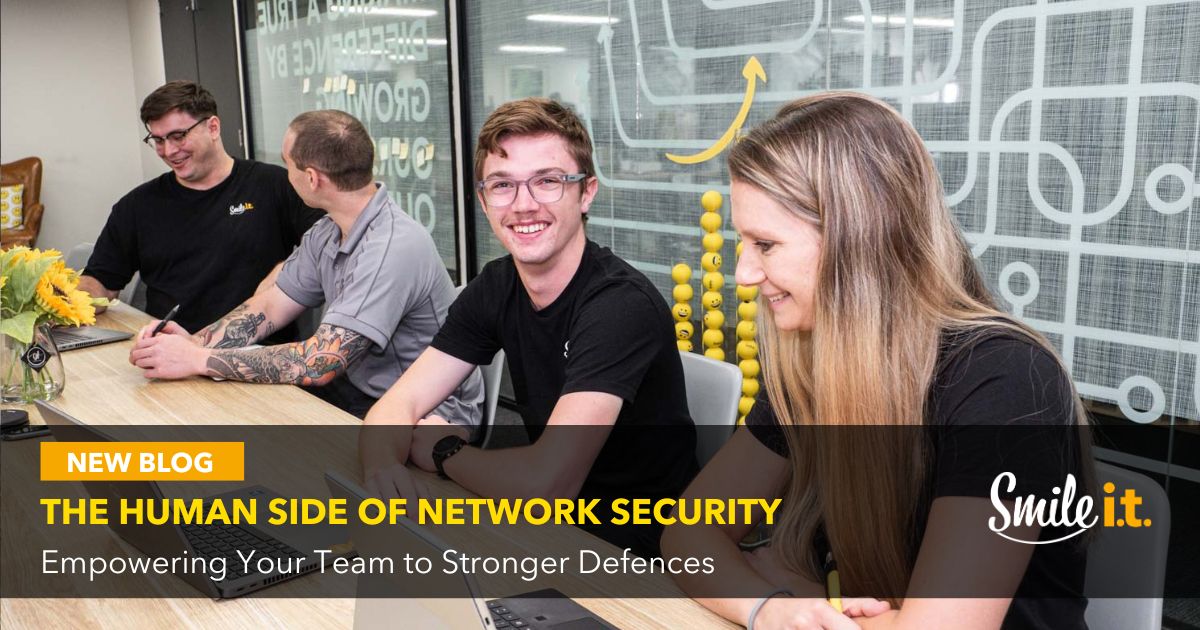You’ve turned your business into a digital fortress. From endpoint protection to firewalls, anti-virus software and 24/7 monitoring, you’ve covered all bases when it comes to network security and keeping the hackers out.
There’s one aspect that’s a little bit trickier to stay on top of though. As a result, hackers relentlessly target it. We’re talking about the human side of network security – the vulnerabilities that arise because humans are… well, human.
We all forget things, get overwhelmed, make mistakes or get led astray. It’s part of being people – unfortunately, it also means that 95% of data breaches arise from human error of some kind.
As businesses across all industries become more reliant on digital systems, it’s time to recognise that empowering and educating your team is an important facet of network security. Human risk is the biggest challenge when it comes to network security, so today we want to look at how humans are exploited, and what can be done to shore up those defences.
Vulnerabilities of Your Team
The growing human element in cyberattacks usually arises from completely unintentional mistakes, although sometimes a disgruntled employee could be going out of their way to sabotage an organisation. Here are three core areas of vulnerability.
Human Error
Slip ups like clicking a dodgy link can seem minor in the moment but have the potential for catastrophe. ‘Phishing’ emails designed to dupe users into thinking they’re from a legitimate source, such as a bank, are getting more common. In our busy work lives we forget to check the finer details of the source – we click, and we input details because it looks legit. This can lead to accidentally downloading malware, providing confidential details on a platter to hackers, or accessing unsafe websites.
Another common error is forgetting to perform updates on operating systems or software. Those updates contain important security patches. If you don’t install them, your network isn’t protected against the latest security threats.
Weak Security Practices
It’s easy to turn security practices into a box-ticking process. For example, creating a password. It’s tempting to throw something together you know you’re going to remember – something trite like your dog’s name followed by your birth year. That’s a weak password though, which is low-hanging fruit for cyber criminals. It pays to put a bit of time and effort into ticking the security boxes, such as creating strong passwords!
Pay attention to your security settings too. If these are done on the fly, you can unintentionally expose sensitive company data with an incorrect setting such as ‘enabling external file sharing by default’.
Social Engineering
Cybercriminals aren’t just tech gurus; they’re also masters of manipulation. Social engineering is a form of attack that is essentially “human hacking”. It uses techniques to manipulate and exploit people, rather than trying to find network or software vulnerabilities like standard cyber-attacks do.
Social engineers basically just ‘trick’ people into giving them what they’re after. It could be a phone call from a fraudster pretending to be from a bank, an invoice dressed up to look like it’s from a common vendor, or an AI-generated voice message that sounds like your CEO asking for confidential information.
How to Improve Your Human Defences
Your team doesn’t have to be your weakest link. To keep them up to speed though, you have to be as relentless as the hackers, prioritising education and policy while building a culture of security. Here’s an introduction into how to do that.
Cybersecurity Awareness Training

Effective training should include real-world simulations, gamification, and up-to-date threat scenarios. Employees who feel equipped are far less likely to make costly mistakes!
Establishing a Network Security Policy
Every business should have a clearly defined network security policy that acts as a blueprint for safe digital behaviour. The policy will outline best practices for password creation, acceptable use of devices, remote access protocols, data classification and incident reporting. It needs to be simple, actionable and accessible, as well as being part of the onboarding process.
Building a Culture of Security
Security shouldn’t be confined to the IT department. It needs to infiltrate through the organisation in a top-down approach, with leadership teams modelling the correct network security behaviours and encouraging all members of staff to do the same. Staff need to be able to ask questions when they’re not sure of something and have no fear of being reprimanded if they speak out about security issues.
Network security should be second nature to your team, like brushing teeth in the morning and locking the door on the way out of your home! Celebrating positive behaviour and sharing success stories will also help make it part of your teams’ identity.
A Holistic Approach to Network Security
Network security is about synergy between your people and your technology. Firewalls, intrusion detection systems, antivirus programs, and endpoint protection are all vital, but can be bypassed without human vigilance.
A holistic approach acknowledges technology and people must work together. It looks like this:
- Technology handles the heavy lifting: automated patching, monitoring tools, secure access controls, and real-time threat alerts.
- People bring context and judgment: recognising suspicious behaviour, reporting anomalies and following policy.
A cohesive security strategy means a far stronger, more resilient network.
Get in Touch with Network Security Experts Smile IT
Cybercriminals are counting on human mistakes to gain access to your network. You can train your team into being powerful security assets rather than potential liabilities though. Smile IT offer cybersecurity awareness training programs to help people-proof your digital defences. We’d love to tell you more about them – get in touch today and chat with one of our team members. Let’s put people at the centre of your network security strategy.
When he’s not writing tech articles or turning IT startups into established and consistent managed service providers, Peter Drummond can be found kitesurfing on the Gold Coast or hanging out with his family!



